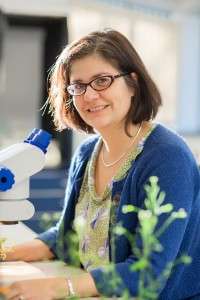Research sows the seeds for improved food security

Research from the University of Bath has shown that is possible to improve both seed size and seed number opening new avenues to increase crop yields and improving food security.
Scientists from the University's Department of Biology & Biochemistry investigating the genetic basis of natural variation in seed size and seed number in plants have discovered that it's possible to maximise both.
With around 850 million people worldwide suffering from chronic hunger and the world population predicted to increase by three billion by 2050, there is an urgent need to increase food production. The effects of climate change and competition for land resources for biofuel production mean it's vital to produce higher yield from the same area of farmland.
Since crops such as oilseed rape and wheat are harvested for seed, this means increasing the total yield obtained per unit area. Seed yield has two major components: seed size and seed number.
It has long been believed that plants that produce more seeds would produce smaller seeds and that plants that produce larger seeds would produce fewer due to genetic trade-offs between these two traits. If this is the case, efforts to improve either of these traits could result in no net gain. The research team at Bath studied the genetic basis of naturally occurring variation in seed size and seed number in the plant Arabidopsis thaliana, a close relative of oilseed rape.
The team used a powerful new tool called Multiparent Advanced Generation Inter-Cross (MAGIC) lines, to identify the precise locations on chromosomes of genes that affect size and number of seeds. They looked at whether the two traits were connected and whether seed size could be increased without detriment to seed number.
The study, published in the academic journal Genetics, found that the traits of seed size and number can potentially be controlled independently because the genetic factors that control them are located on different parts of the genome.
Dr Paula Kover, Senior Lecturer in Genetics at the University of Bath who led the study, explained: "People have previously thought that there's always a trade-off, that producing bigger seeds would lead to smaller seed numbers and vice versa.
"This study shows it's actually possible to increase both seed size and seed number. These results are very promising, especially for food security.
"The next step is to narrow and to identify the exact genes involved in seed size and seed number so that we can use breeding techniques to maximise yields."
More information: "The Genetic Basis of Natural Variation in Seed Size and Seed Number and Their Trade-Off Using Arabidopsis thaliana MAGIC Lines" Genetics genetics.114.170746; Early online October 13, 2014, DOI: 10.1534/genetics.114.170746
Journal information: Genetics
Provided by University of Bath


















